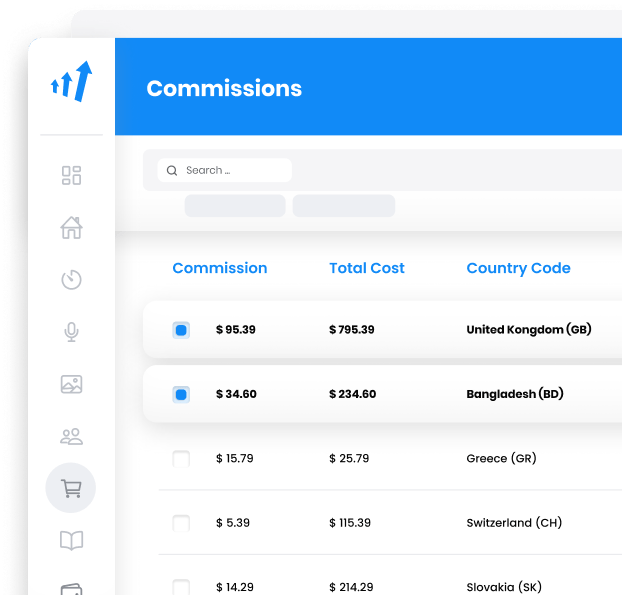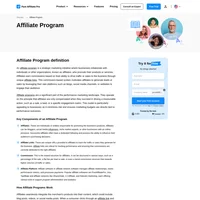What are Loyalty Affiliates?
Loyalty affiliates are a specialized type of affiliate marketing entity that incentivizes consumers to take specific actions, usually leading to a sale, by offering rewards. These rewards can be in the form of cashback, redeemable points, discounts, access to exclusive products, or even contributions to charitable causes. Loyalty affiliates harness their established audience trust to drive higher engagement and conversions for the brands they represent.
Loyalty affiliates function as a bridge between consumers and brands by providing a value-added service. They are adept at building relationships and trust with consumers by offering tangible rewards, thereby encouraging repeat purchases and long-term engagement. By integrating loyalty programs into their affiliate marketing strategies, businesses can enhance customer satisfaction and foster brand loyalty.

Key Characteristics of Loyalty Affiliates
- Reward-Driven Motivation: Loyalty affiliates leverage rewards to motivate consumer actions. This could mean offering a small percentage of cashback on purchases or accumulating points that can be redeemed for discounts or free products. This reward-driven model is particularly effective as it directly aligns consumer interests with affiliate goals.
- Performance-Based Model: Like traditional affiliates, loyalty affiliates operate on a performance-based compensation model where they earn commissions based on the sales or leads they generate. This model ensures that affiliates are incentivized to drive quality traffic and conversions, aligning their success with the brand’s goals.
- Consumer Trust and Engagement: These affiliates build trust with consumers by offering genuine value through incentives, which often results in long-term customer engagement and loyalty. Trust is a crucial element, as consumers are more likely to engage with affiliates that consistently deliver on their promises.
How Loyalty Affiliates Work
- Customer Engagement: Loyalty affiliates engage their audience by presenting value-added propositions like cashback or points on purchases. This encourages consumers to make a purchase or take specific actions that benefit both the affiliate and the merchant. Through engaging content and strategic marketing, affiliates can effectively communicate the value of their programs.
- Incentive Structures: The incentives offered can vary widely. Some affiliates might focus on cashback offers, while others may provide points that can be redeemed for discounts or exclusive offers. The flexibility in incentive structures allows brands to tailor their affiliate programs to suit specific marketing objectives and consumer preferences.
- Performance Metrics: The success of loyalty affiliates is measured by the number of conversions they drive. This includes sales, sign-ups, or other predefined actions that result in a commission for the affiliate. By utilizing advanced tracking technologies, affiliates and brands can monitor performance and adapt strategies to maximize ROI.
Examples and Scenarios
Example 1: Cashback Site
A popular cashback site partners with a major retailer. Every time a consumer makes a purchase through the site, they receive a percentage of the purchase as cashback. This motivates the consumer to continue shopping through the cashback site, driving sales for the retailer and earning commissions for the affiliate. Cashback sites often have well-established algorithms to track purchases and reward consumers accordingly.
Example 2: Points-Based Loyalty Program
An electronics retailer partners with a loyalty affiliate that offers points for every purchase. These points can be redeemed for discounts on future purchases. A consumer buys a laptop and earns points, which they later use to purchase accessories, thereby maintaining a cycle of engagement and sales. Points-based systems are popular for their gamification potential, which can significantly boost consumer interaction.
Advantages of Partnering with Loyalty Affiliates
- Increased Brand Visibility: Loyalty affiliates often have a dedicated user base that trusts their recommendations, which can significantly enhance a brand’s visibility and reach. By tapping into these established networks, brands can access a wider and more engaged audience.
- Cost-Effective Marketing: Since affiliates are compensated based on performance, brands can achieve effective marketing without incurring upfront costs, making it a cost-effective strategy. This model is particularly beneficial for startups and small businesses seeking to maximize their marketing budgets.
- Enhanced Consumer Loyalty: By offering rewards, brands can enhance consumer loyalty and retention, encouraging repeat purchases and long-term engagement. Reward programs can serve as a differentiator in competitive markets, attracting consumers who value added benefits.
- Access to Niche Audiences: Affiliates often cater to niche audiences, allowing brands to target specific consumer segments that might otherwise be difficult to reach. This targeting is particularly advantageous for brands looking to penetrate niche markets or launch new products.
Best Practices for Engaging with Loyalty Affiliates
- Clear Communication: Establish clear expectations and communication channels with affiliates to ensure the partnership aligns with brand goals and consumer expectations. Regular updates and feedback can enhance collaboration and effectiveness.
- Transparent Incentive Structures: Clearly outline the incentive structures, ensuring affiliates understand how they will be rewarded and what actions are prioritized. Transparency builds trust and motivates affiliates to focus on delivering quality results.
- Quality Over Quantity: Focus on building relationships with quality affiliates who align with your brand values and can effectively engage your target audience. Quality affiliates contribute to a sustainable and successful affiliate program.
- Regular Performance Monitoring: Utilize tracking and analytics tools to monitor affiliate performance and optimize strategies based on data-driven insights. Continuous monitoring helps in identifying top-performing affiliates and areas for improvement.
Challenges and Considerations
While loyalty affiliates offer numerous benefits, brands should be aware of potential challenges, such as:
Balancing Incentives: Finding the right balance between attractive consumer incentives and sustainable affiliate compensation is essential to maintaining a profitable program. Overly generous incentives may erode profit margins, while insufficient rewards may fail to motivate consumers.
Quality Control: Ensuring affiliates maintain high-quality standards and align with the brand’s image is crucial. Affiliates who engage in misleading practices can harm brand reputation. Regular audits and compliance checks can help mitigate this risk.
Compliance and Ethics: Affiliates must adhere to legal and ethical guidelines, including transparent disclosure of affiliate relationships to consumers. Brands should ensure affiliates are aware of and comply with these guidelines to avoid legal repercussions.

Customer Loyalty Programs: A Strategic Asset in Affiliate Marketing
Customer loyalty programs are an essential component of a successful business strategy. They not only help in retaining existing customers but also enhance profitability significantly. For businesses involved in affiliate marketing, understanding and implementing effective loyalty programs can be a game-changer.
The Value of Customer Retention
Retaining existing customers is more cost-effective than acquiring new ones. Studies show that increasing customer retention rates by just five percent can lead to a profit increase ranging from 25 to 95 percent. This principle is especially relevant in affiliate marketing, where cultivating brand loyalty can exponentially increase the lifetime value of a customer.
Types of Customer Loyalty Programs
Loyalty programs come in various forms, each offering unique benefits and challenges. Here are four major types:
Points-Based Systems
A common choice, points-based systems reward customers for their purchases and other actions like signing up for newsletters or sharing on social media. Though effective, the system must be straightforward and generous to motivate customer engagement.
Tiered Programs
Tiered loyalty programs rank customers based on their spending or engagement levels, offering increasing benefits as they climb higher. This model encourages continuous interaction with the brand and can be especially effective if alternative ways to climb tiers, like participating in surveys, are offered.
Paid Loyalty Programs
These require customers to pay for access to perks, which can include early access to products or exclusive community membership. While a harder sell, these programs can be lucrative and often easier for customers to understand, translating into increased spending.
Value-Based Loyalty
This model aligns with customers’ values by donating to charities on their behalf. It strengthens customer trust, particularly for brands committed to social responsibility.
Implementing Loyalty Programs in Affiliate Marketing
In affiliate marketing, partners can leverage loyalty programs to enhance customer retention and drive more sales. By aligning loyalty rewards with affiliate promotions, businesses can create a synergistic effect that boosts both customer satisfaction and affiliate earnings.
Real-World Examples
Companies like Bloom, Third Love, Sephora, DSW, and Starbucks have implemented innovative loyalty programs that affiliates can learn from. These programs not only encourage repeat purchases but also build strong brand communities, which is crucial for long-term success in affiliate marketing.
Conclusion
For businesses utilizing affiliate marketing, integrating a well-structured customer loyalty program can significantly enhance customer retention and profitability. By selecting the right type of program and aligning it with affiliate strategies, businesses can foster a loyal customer base that continually contributes to their bottom line.
FAQs
What are the benefits of a loyalty program in affiliate marketing? Loyalty programs can increase customer retention, boost repeat purchases, and enhance the overall profitability of affiliate marketing efforts.
How do points-based loyalty programs work? Customers earn points for actions like purchases and social shares, which they can redeem for rewards, thereby increasing brand engagement.
What makes a tiered loyalty program effective? A tiered program rewards customers based on their engagement, encouraging continuous interaction and loyalty through progressively better rewards.
Can loyalty programs be integrated with affiliate marketing? Yes, loyalty programs can complement affiliate marketing strategies by incentivizing repeat purchases and enhancing customer loyalty.
Frequently Asked Questions
Why brands partner with loyalty affiliates?
There are many reasons why brands partner with loyalty affiliates such as increasing brand awareness, increasing sales, and creating a competitive advantage.
Is there an additional cost to working with loyalty affiliates?
There may be an additional cost to working with loyalty affiliates, depending on the terms of the agreement.
Discover how SEO affiliates can enhance your site's search rankings and drive organic traffic with expert search engine optimization strategies. Learn about the benefits of combining affiliate marketing with SEO for a cost-effective approach to boost your online presence. Explore the role of SEO affiliates and elevate your brand's visibility.
Discover the role of an affiliate in marketing—earn commissions by promoting products through banners, links, and campaigns. Learn how affiliates drive sales and explore effective marketing strategies. Join the world of affiliate marketing with Post Affiliate Pro for user-friendly tools and exceptional support.










